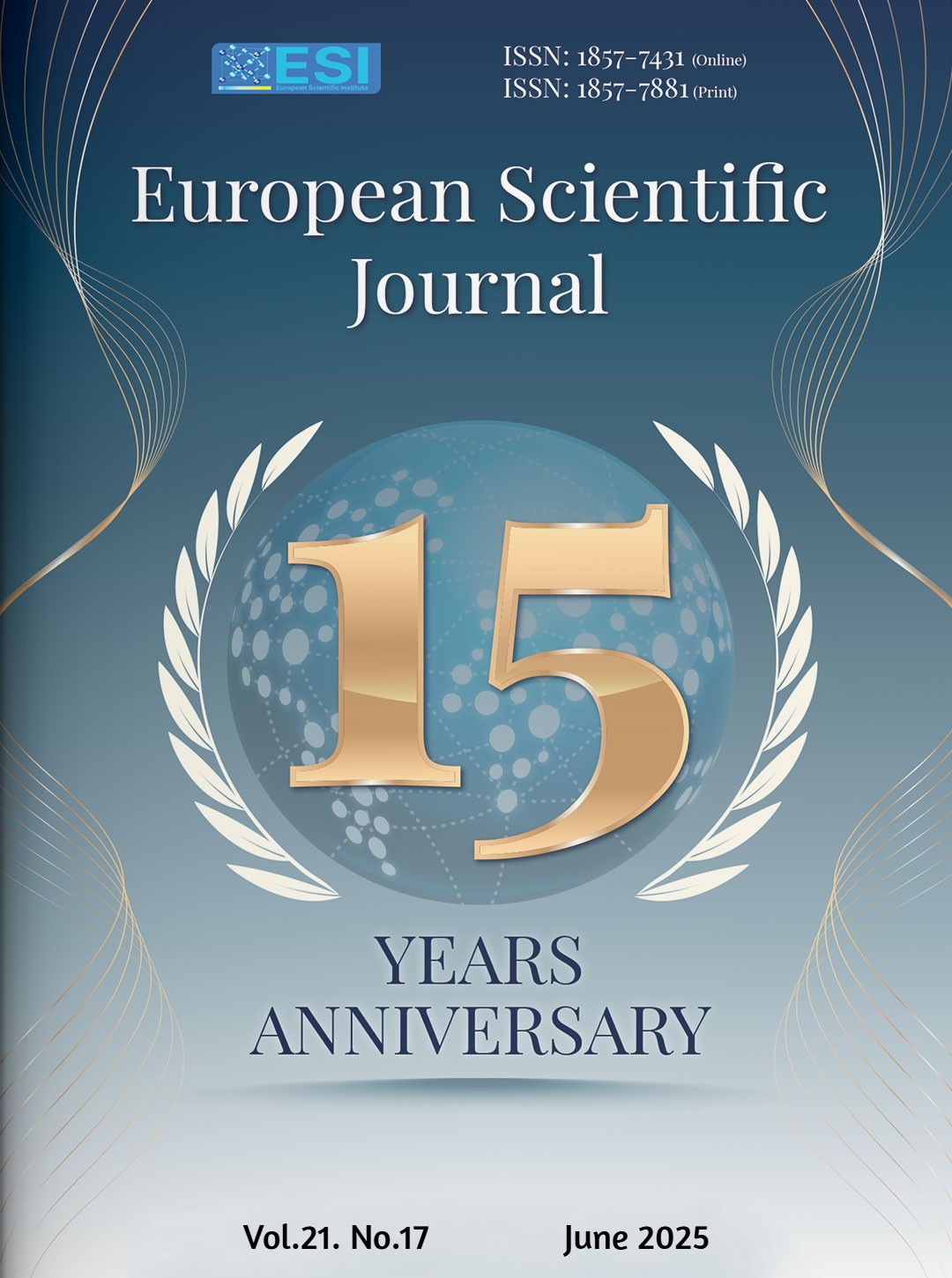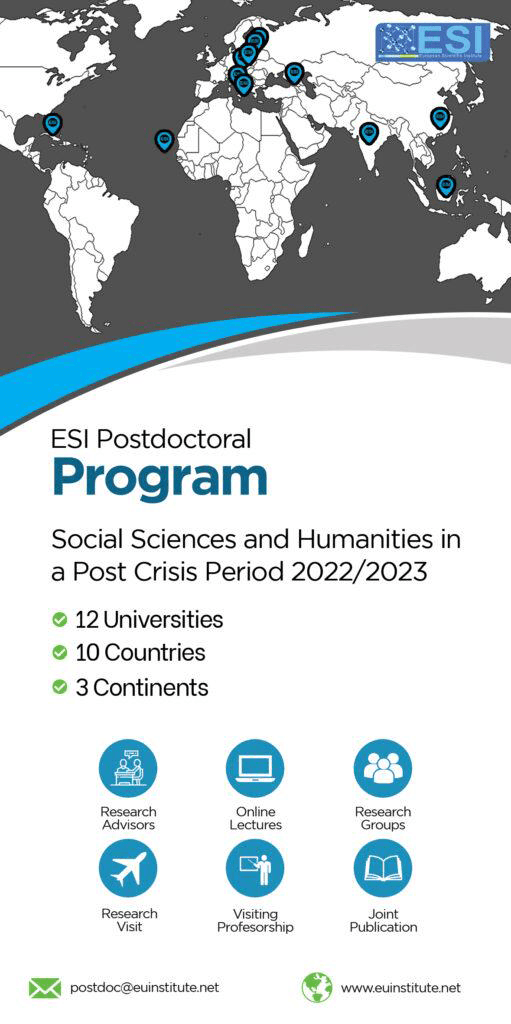The Role of BRICS in Reshaping the Global Order: Confronting Western Hegemony in a Multipolar World
Abstract
This study examines the role of the BRICS group in reshaping the structure of the global order. The scientific significance of the research lies in its contribution to understanding the mechanisms of global systemic transformation and its historical trajectory. Practically, the study aims to explain the factors behind the redistribution of power within the international system and the implications of this shift. The central research problem is framed by the following question: What is the role of the BRICS group in transforming the structure of the global order? From this, several sub-questions emerge concerning the current state of the global system, the nature and institutional structure of BRICS, the group’s vision of the international order, and its influence on global power dynamics. The study is based on the central hypothesis that the increasing global influence of BRICS signals a redistribution of power within the international system, potentially leading to a decline in the hegemonic role of the United States of America (U.S.A.). The research employs a historical approach to trace the evolution of international relations and power structures, as well as a descriptive approach to examine the characteristics, goals, and strategic behaviour of the BRICS countries.
The study tracks the development of BRICS from its emergence as an economic concept in 2001 to its evolution into a politically and economically significant bloc. It analyses the group's stance on Western hegemony and its initiatives aimed at restructuring global financial and governance systems. The findings indicate that BRICS plays an increasingly influential role in challenging the United States (U.S.)-led unipolar system. The group has made notable progress in building institutional alternatives to traditional Western-dominated financial bodies, supporting efforts to curtail American financial dominance. Despite internal divisions and geopolitical disparities, BRICS is emerging as a significant force promoting a transition toward a multipolar world order, though its role remains complex and not without contradictions.
Downloads
Metrics
PlumX Statistics
References
2. Al-Dhahir, N. (2007). Contemporary political geography in light of a new international order (1st ed.). Al-Yazouri Scientific Publishing House.
3. Anthony, I., & Krieckp, M. (2023). BRICS+ partnership network: Expanding global influence. Routledge.
4. Bremmer, I. (2013). A world without leadership - Every nation for itself: Winners and losers in a zero-sum world (F. Al-Dhahabi, Trans.; 1st ed.). Dar Al-Farabi.
5. Brzezinski, Z. (2012). Strategic vision: America and the crisis of global power. Basic Books.
6. Eichengreen, B. (2021). Exorbitant privilege: The rise and fall of the dollar. Princeton University Press.
7. Fahmy, A. Q. M. (1995). The international political system - A study in theoretical origins and contemporary characteristics (1st ed.). House of General Cultural Affairs (Arab Horizons).
8. Guyatt, N. (2003). Another American century? The United States and the world since 9/11. University Bangladesh Press.
9. Hashim, N. J. (2020). America and the rising power: American policy towards BRICS countries in the global order (1st ed.). Al-Matbu'at Company for Distribution and Publishing.
10. Hettne, B., & Oden, B. (2002). Global governance in the 21st century: Alternative perspectives on world order. Edita Norstedts Tryckeri AB.
11. Kleib, S. (2017). Verbal-active pragmatics in the analysis of political discourse acts: Trump's and King Salman's speeches as a model. Dar Al-Farabi.
12. Little, R. (2009). Balance of power in international relations - Metaphors, myths and models (H. Nabri, Trans.; 1st ed.). Dar Al-Kitab Al-Arabi.
13. Mingst, K. A. (2003). Essentials of international relations (2nd ed.). W.W. Norton & Company.
14. Mohammed, S. M. M. (2015). Middle powers in the international system: The case of Brazil 2002-2010. Gulf Research Center.
15. Sandrey, R., et al. (2013). BRICS: South Africa why ahead. Tralae Trade Law Center.
16. Sobh, A. (1998). International conflict in half a century 1945-1995. Dar Al-Manhal Al-Lubnani.
17. Stuenkel, O. (2015). The BRICS and the future of global order. Lexington Books.
18. Wolff, E. (2016). The International Monetary Fund: A superpower in the global arena (A. A. Ali, Trans.). National Council for Culture, Arts and Literature.
19. Zakaria, F. (2009). The post-American world: Release 2.0. W.W. Norton & Company.
20. Zidane, N. (2013). Russia's role in the Middle East and North Africa from Peter the Great to Vladimir Putin (1st ed.). Arab Science Publishers.
21. Al-Alyawi, S. M. S. (2020). The impact of the BRICS group on structuring the multipolar world order. Al-Kufa Journal of Legal and Political Sciences, 13(45/1), 215-264.
22. Bhandari, R. K. (2023). Reform of the multilateral system: New perspectives. Journal of Global Governance, 15(2), 175-182.
23. Dailami, M., & Masson, P. (2011). Prospects for a multipolar international monetary system. DISS Report, Danish Institute for International Studies, 7.
24. Dogan, M., et al. (2021). BRICS exchange alliance: Connecting emerging markets. International Financial Review, 32(3), 215-220.
25. Griffith-Jones, S. (2023). New Development Bank: Alternative financing for the Global South. Development Policy Review, 41(1), 46-52.
26. Horber, S., et al. (2024). E7 economic powers: The new global economic elite. Journal of International Economics, 135, 112-115.
27. Horn, N., & Watson, M. (2022). Alternative global governance models. International Organization, 76(2), 78-85.
28. Huesken, F. W. (2012). International systems, polarity, cyber technology and stability. Journal of Science, Technology, Ethics, and Policy, 41-43.
29. Issa, M. A. S. (2012). International economic problems: BRICS grouping as a model. International Politics Journal, Cairo: Al-Ahram Foundation, 51(50/200).
30. Karaganov, S. (2023). Shanghai Cooperation Organization: A new security architecture. International Security, 47(3), 52-58.
31. Katzouev, S. (2022). Military cooperation in the BRICS: Symbolic and strategic dimensions. Journal of Strategic Studies, 45(4), 318-324.
32. Mashigo, T. (2023). BRICS maritime exercises: Building naval cooperation. Naval War College Review, 76(3), 294-301.
33. Morris, J. (2013). Libya and Syria: R2P and the spectre of the swinging pendulum. International Affairs, 89(5), 1265-1283.
34. Narlikar, A. (2022). World Trade Organization and development: Challenges and opportunities. Journal of Development Studies, 58(1), 43-50.
35. Nayar, D. (2022). UN reform and representation: The case for Global South. International Affairs, 98(4), 132-138.
36. Patel, R. (2022). Regional integration and global governance. Global Governance: A Review of Multilateralism, 28(2), 201-208.
37. Patel, R. (2023). Trading with sanctioned states: Economic resilience in the age of sanctions. International Political Economy, 30(3), 187-193.\
38. Purugganan, J., et al. (2013). BRICS: A civil society perspective. Focus on the Global South, Bangkok, 5.
39. Roberts, J., et al. (2023). Sanctions countermeasures: Building economic sovereignty. Journal of Economic Warfare, 4(2), 254-260.
40. Samar, H. M. (2023). Development priorities in the Global South: Food, energy, and finance. Third World Quarterly, 44(2), 65-72.
41. Scaffardi, L. (2014). BRICS, a multi-centre "legal network"? Beijing Law Review, 5, 141.
42. Sharma, R., & Mishra, P. (2023). Regional organizations in global governance. International Studies Quarterly, 67(3), 201-208.
43. Singh, H., & Sharma, N. (2023). BRICS Pay: Alternative payment mechanisms. Journal of International Financial Markets, 15(2), 76-80.
44. Sinath, K., & Castillo, M. (2023). BRICS appeal to the Global South: Legitimacy and geopolitical support. Review of International Studies, 49(3), 415-422.
45. Standage, T. (2023). Historical transitions in the global monetary system. Review of International Economics, 31(2), 213-217.
46. Subrahmanyam, S. (2023). World Bank lending criteria: A critical assessment. Development and Change, 54(1), 64-70.
47. Thakur, R. (2022). BRICS voice: Alternative media platforms in international relations. Media, Culture & Society, 44(2), 277-284.
48. Wang, Y. (2022). Contingent reserve arrangement: Alternative to the IMF. Review of International Organizations, 17(2), 174-180.
49. Wilson, D. (2024). Financial messaging systems: SPFS and CIPS as alternatives to SWIFT. Journal of Banking & Finance, 150, 73-80.
50. Woods, N. (2021). IMF voting reforms: Shifting the balance of power. International Organization, 75(3), 782-785.
51. Ding, S. (2006). Soft power and the rise of China: An assessment of China's soft power in its modernization process (Doctoral dissertation). Newark, New Jersey.
52. Pant, H. V. (2013). India in Afghanistan: A rising power or a hesitant power? CIPSS, Université de Montréal -McGill University.
53. Wso, A. A. (2024). Soğuk savaş sonrası dönemde Çin dış politikasında keskin güç uygulaması: Avustralya örneği. (Doctoral dissertation). Karadeniz Teknik Üniversitesi.
54. Aparajita, B. (2023). BRICS currency and the dollar debate. Observer Research Foundation. Available on https://www.orfonline.org/research/brics-currency-and-the-dollar-debate (Accessed on March 20, 2025).
55. Åslund, A. (2012). The BRICS group will not benefit Russia. Al Jazeera, no. 14433, 4 April. Available at: http://www.al-jazirah.com (Accessed: 18 April 2025).
56. Bond, P. (2013). BRICS in Africa: Anti-imperialist, sub-imperialist or in between? Johannesburg: The Center for Civil Society, Ground Work and South Community Environment Alliance. Available at: https://ccs.ukzn.ac.za/publications (Accessed: 02 May 2025).
57. BRICS. (2021). New Delhi Declaration. Available on https://brics2021.gov.in (Accessed on May 14, 2025).
58. CUTS Center for International Trade. (2013). BRICS and the world order: A beginner's guide. Jaipur: CUTS International. Available at: https://www.cuts-international.org/publications (Accessed: 19 April 2025).
59. Gabuev, A., & Stuenkel, O. (2024). The U.S. shouldn't dismiss BRICS challenge. Carnegie Endowment for International Peace, 29 October. Available at: https://carnegieendowment.org/russia-eurasia/politika/2024/10/brics-summit-us-challenge (Accessed: 29 March 2025).
60. Goldman Sachs. (2003). Dreaming with BRICS: The path to 2050. Global Economics Paper No. 99. New York: Goldman Sachs Financial Workbench. Available at: https://tinyurl.com/2mm9d3rt (Accessed: 10 March 2025).
61. Goldman Sachs. (2005). How solid are the BRICS? Global Economics Paper No. 134. New York: Goldman Sachs Economic Research. Available at: https://www.goldmansachs.com/insights/archive (Accessed: 08 April 2025).
62. High-Level Panel on Global Governance. (2023). Transforming global governance: Towards a more equitable system. Geneva: United Nations Publications. Available at: https://www.un.org/publications (Accessed: 09 March 2025).
63. IMF. (2023). World economic outlook. Washington D.C.: International Monetary Fund. Available at: https://www.imf.org/en/Publications/WEO (Accessed: 02 April 2025).
64. Independent Expert Group. (2023). Report on multilateral reform. Geneva: United Nations Publications. Available at: https://www.un.org/publications (Accessed: 27 March 2025).
65. Ilik, G., & Adamczyk, A. (2025). The EUs compensatory power amid global transactionalism. Studia Europejskie- Studies in European Affairs, 1(2025), 155-171. https://doi.org/10.33067/SE.1.2025.8 (Accessed: 03 June 2025).
66. John, L. (2012). Engaging BRICS: Challenges and opportunities for civil society. New Delhi: Oxfam India Working Papers Series. Available at: https://www.oxfamindia.org/working-papers (Accessed: 18 April 2025).
67. Kappel, R. (2015). Global power shifts and challenges for the global order. Policy Paper 2/2015. Hamburg: German Institute of Global and Area Studies. Available at: https://tinyurl.com/4kmfyjkb (Accessed: 03 May 2025).
68. Kipgen, K. T., & Chakrabarti, S. (2022). The politics underpinning the BRICS expansion. Journal of Liberty and International Affairs, 8(3), 445-458. https://doi.org/10.47305/JLIA2283445k (Accessed: 02 June 2025).
69. Lauterbach Institute. (2023). Cultural hegemony and alternative discourses in global politics. Berlin: Lauterbach Publications. Available at: https://www.lauterbach-institute.org/publications (Accessed: 27 April 2025).
70. Maihold, G. (2023). BRICS nations offer a new world order as alternative to the West. Frontline. Available at: https://frontline.thehindu.com/news/brics-nations-offer-a-new-world-order-as-alternative-to-the-west/article66667657.ece (Accessed: 12 April 2025).
71. New Development Bank. (2023). Annual report. Shanghai: New Development Bank. Available at: https://www.ndb.int/publications (Accessed: 12 April 2025).
72. O'Neill, J., et al. (2005). How solid are the BRICS? Global Economics Paper No. 134. New York: Goldman Sachs. Available at: https://www.goldmansachs.com/insights/archive (Accessed: 04 May 2025).
73. Pant, H. V., & Saha, P. (2020). India and the BRICS: Norms, contestation, and the search for consensus. Rising Powers Quarterly, 5(1), 7-23. Available on https://risingpowersproject.com/quarterly/india-and-the-brics-norms-contestation-and-the-search-for-consensus (Accessed: May 12, 2025).
74. Sharma, B. P. (2021). China-India new intricacies: Rivalry and cooperation in a new changing global context. Journal of Liberty and International Affairs, 7(3), 280-298. https://doi.org/10.47305/JLIA2137280sh (Accessed: 03 June 2025).
75. The World Financial Review. (2023). Trends and prospects of de-dollarization in the rapidly changing global economy -Part two. 28 September. Available at: https://worldfinancialreview.com/trends-and-prospects-of-de-dollarization-in-the-rapidly-changing-global-economy-part-two/ (Accessed: 15 May 2025).
76. Xiaoyun, L., & Carey, R. (2014). The BRICS and the international development system: Challenge and convergence? Evidence Report No. 58. Brighton: Institute of Development Studies. Available at: https://www.ids.ac.uk/publications (Accessed: 29 March 2025).
77. Xiaoyun, L., & Carey, R. (2016). The BRICS in international development: The new landscape. Brighton: IDS, University of Sussex. Available at: https://www.ids.ac.uk/publications (Accessed: 04 May 2025).
Copyright (c) 2025 Aram A. Wso, Rawa M. Mahmood

This work is licensed under a Creative Commons Attribution 4.0 International License.








